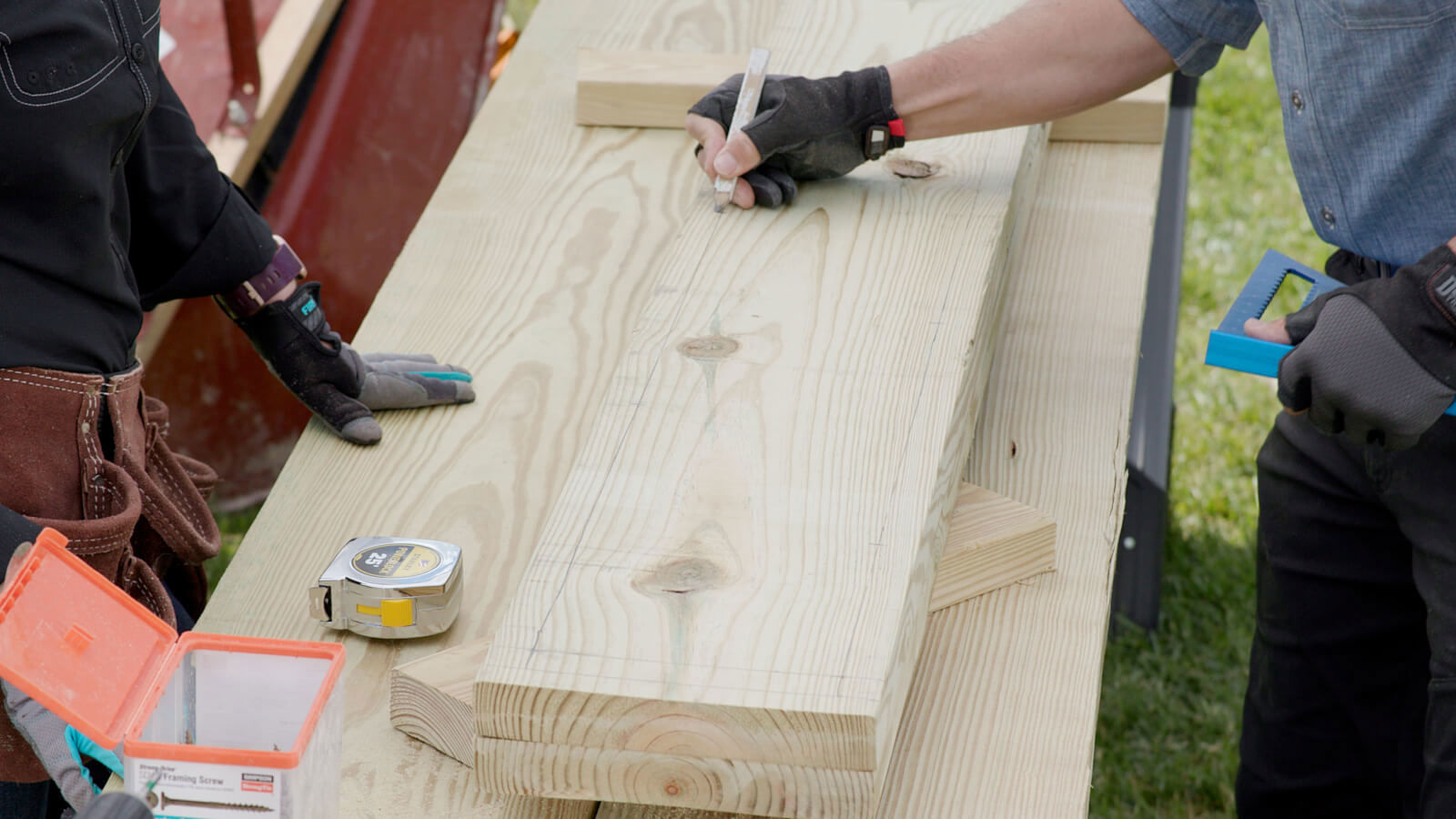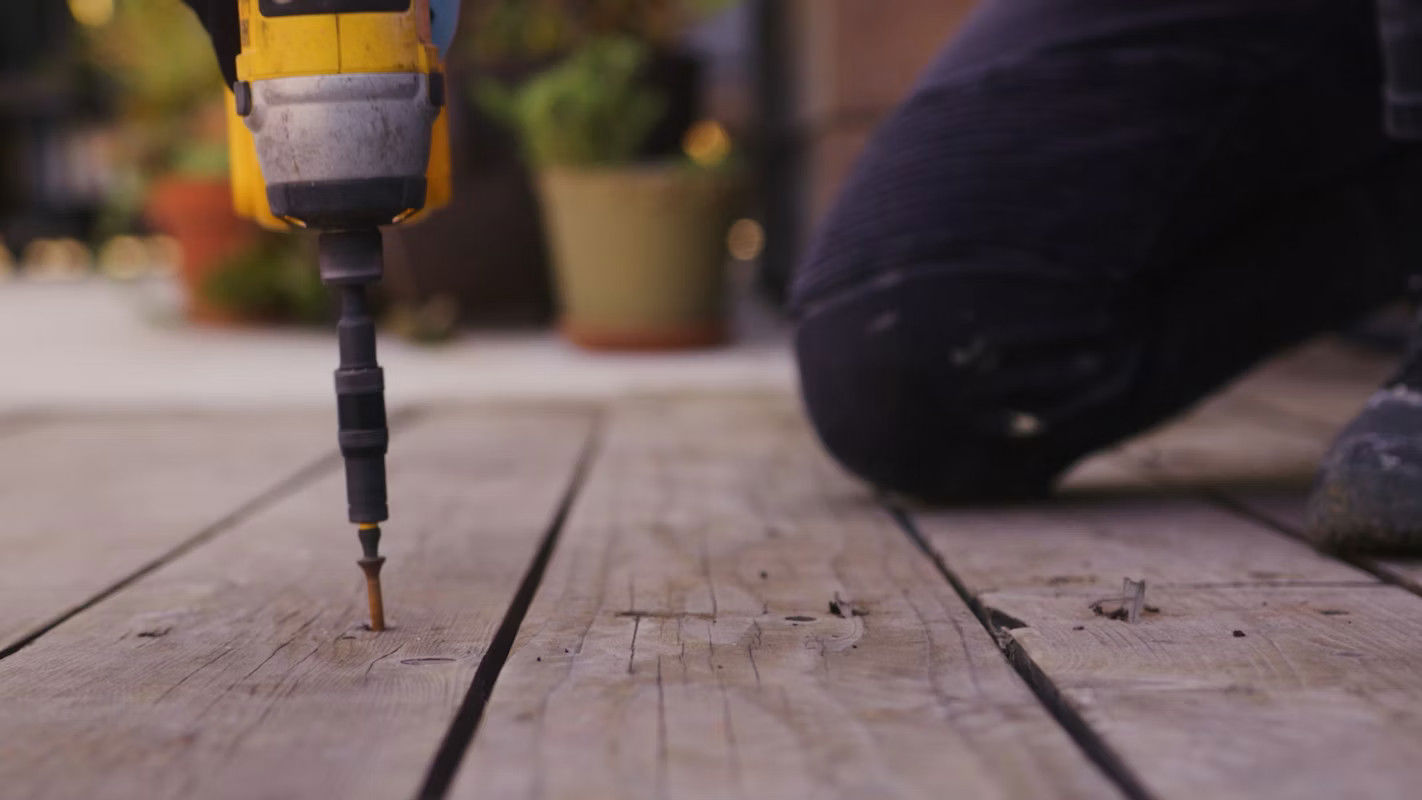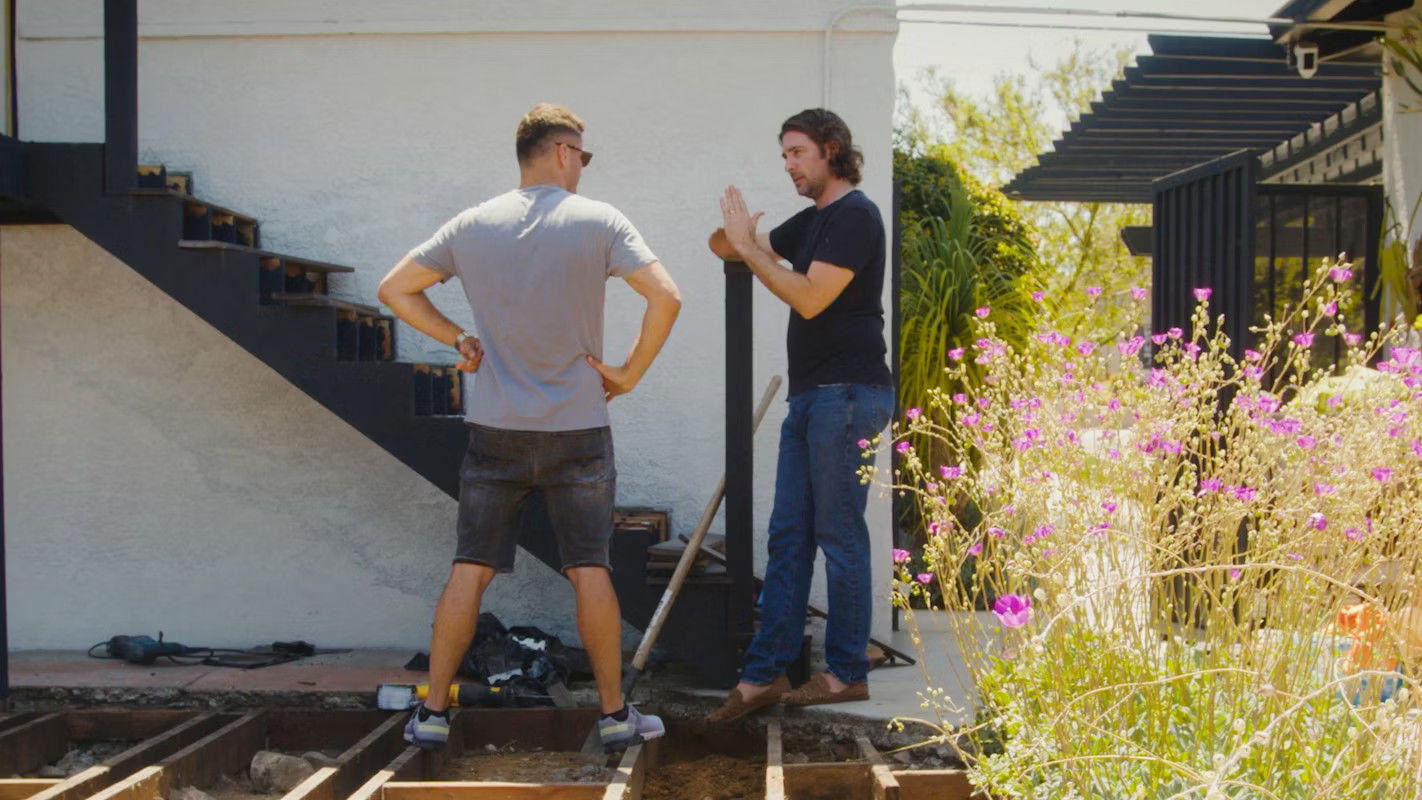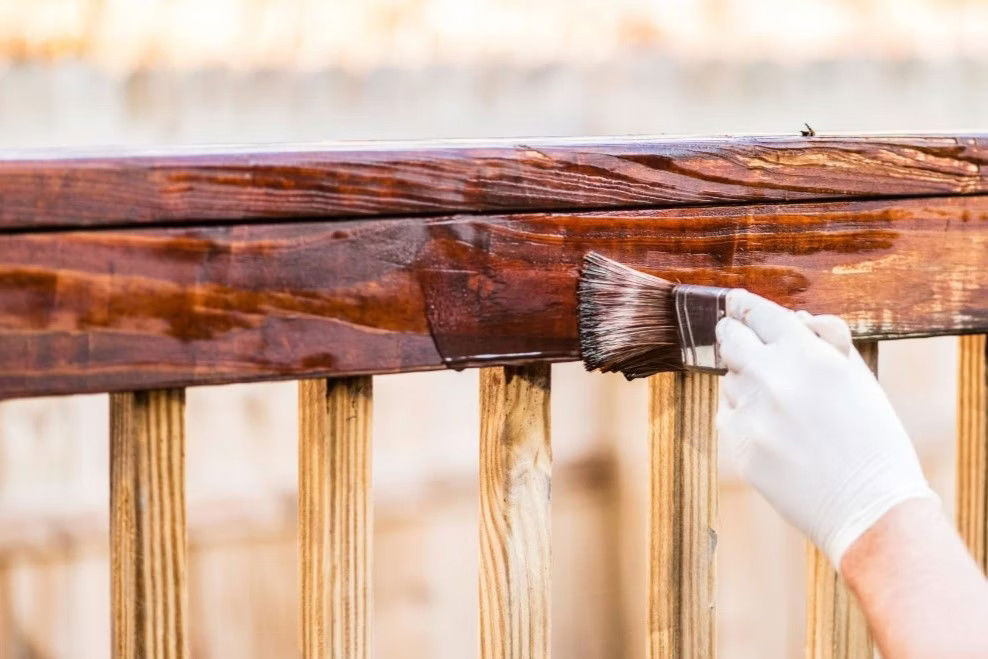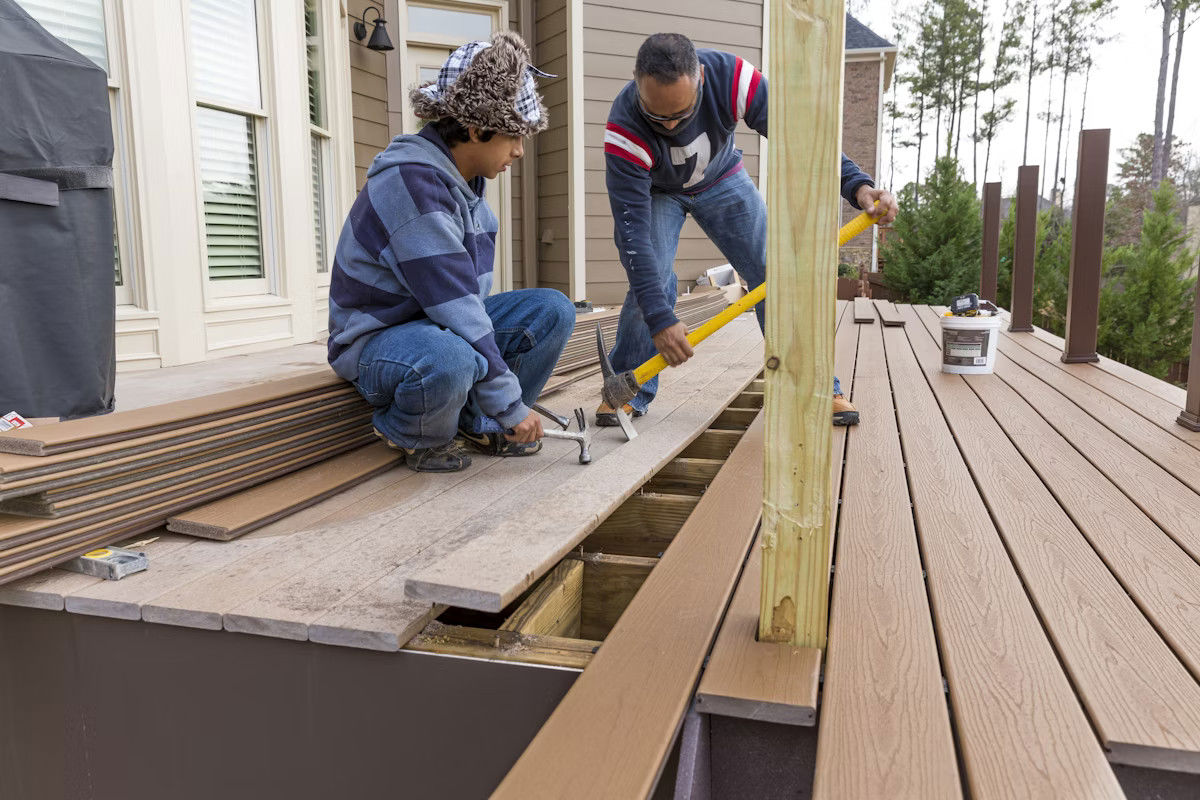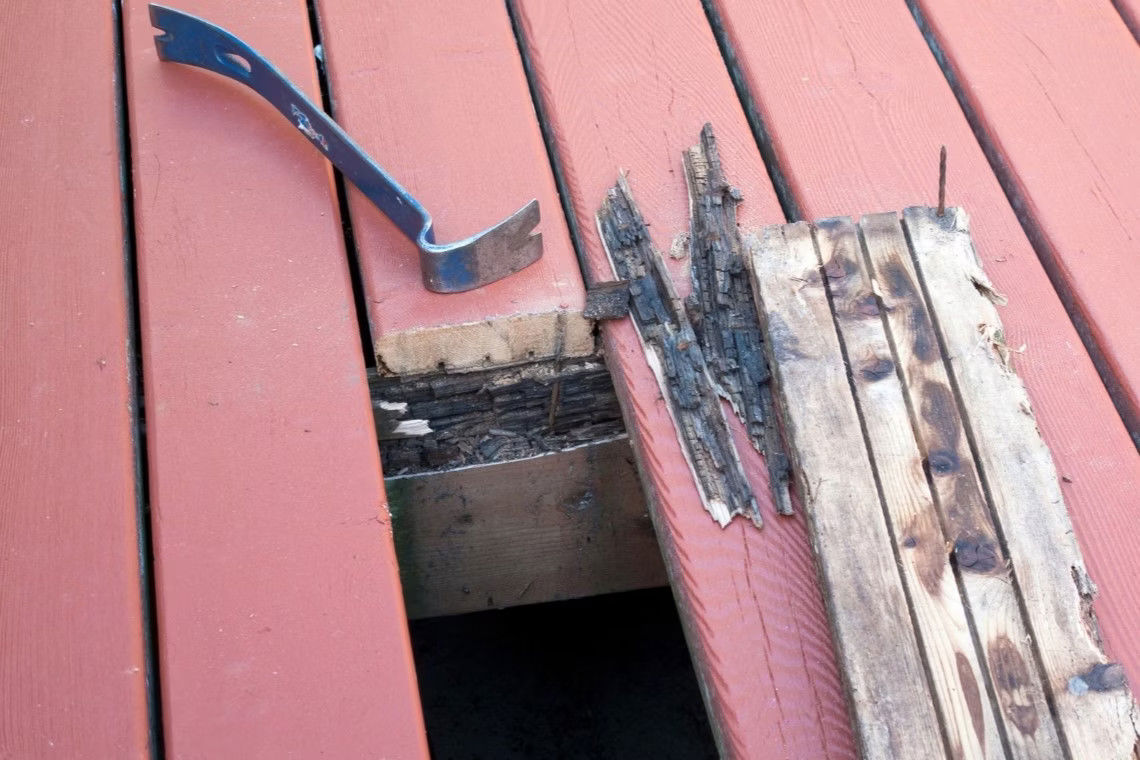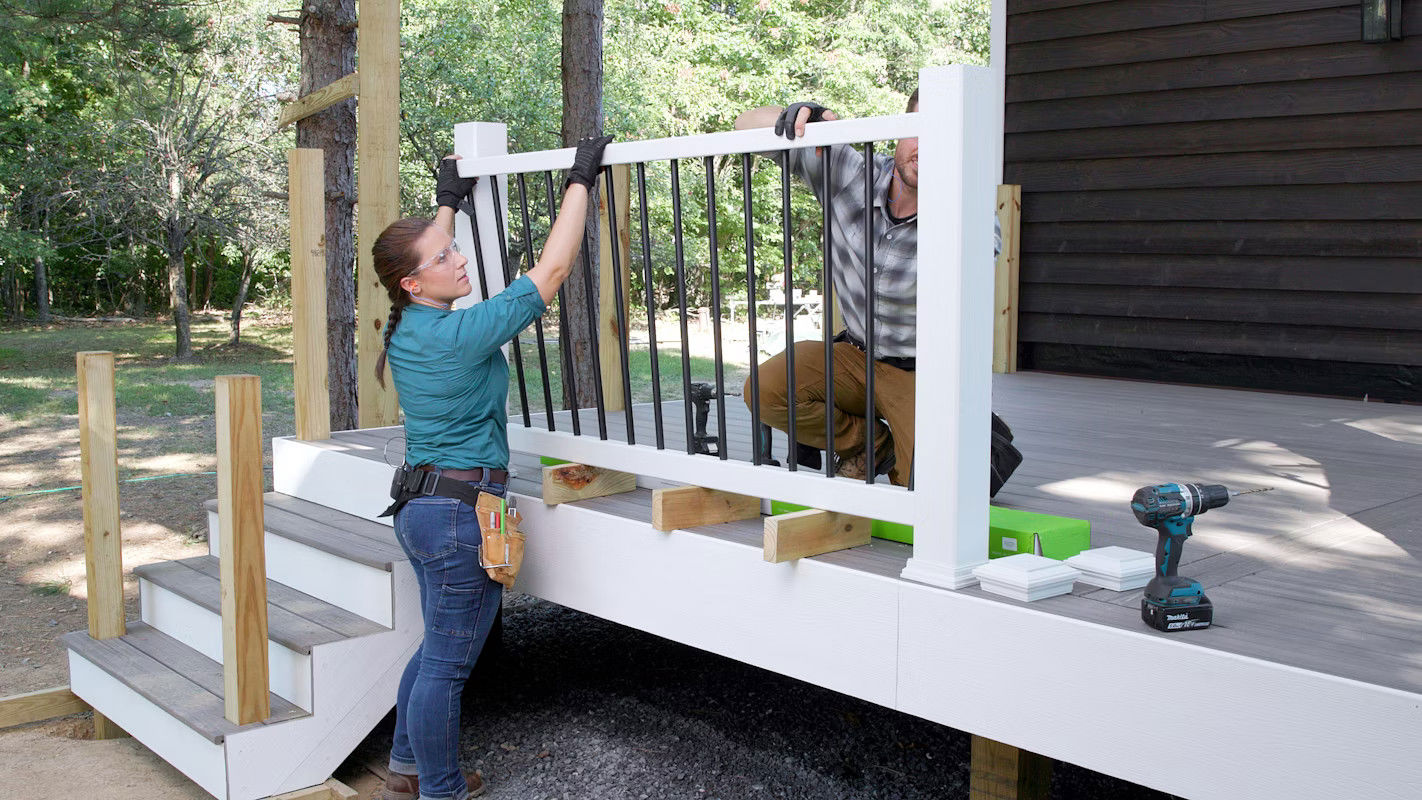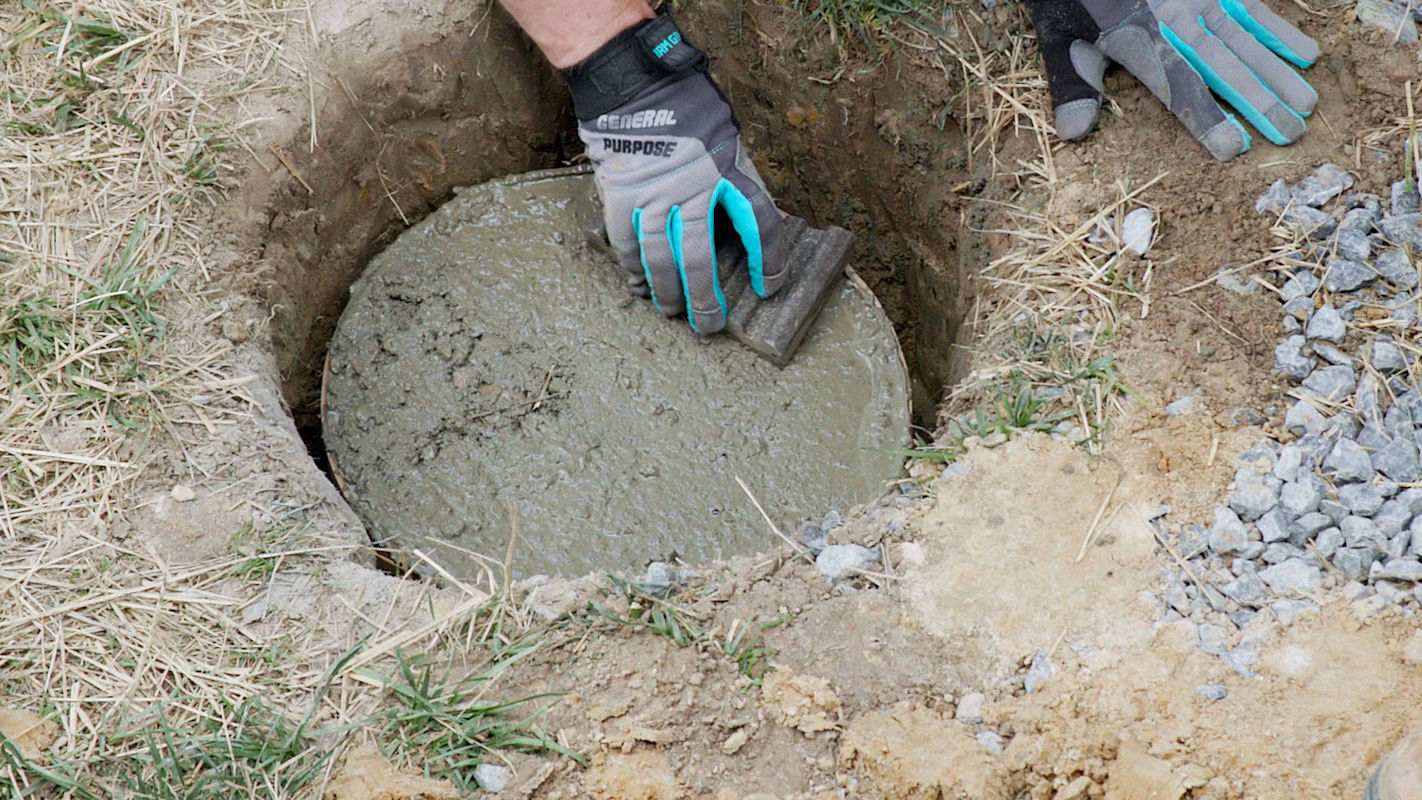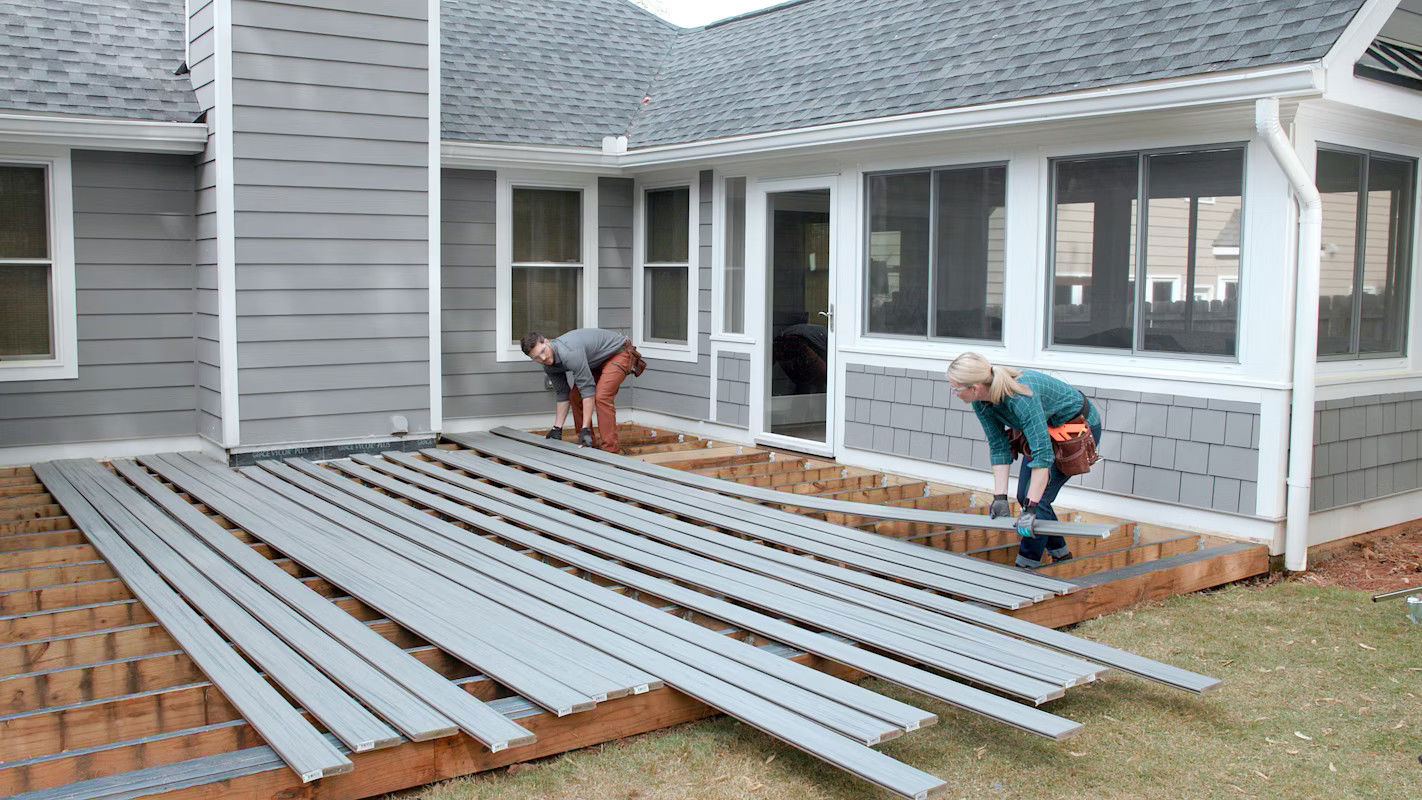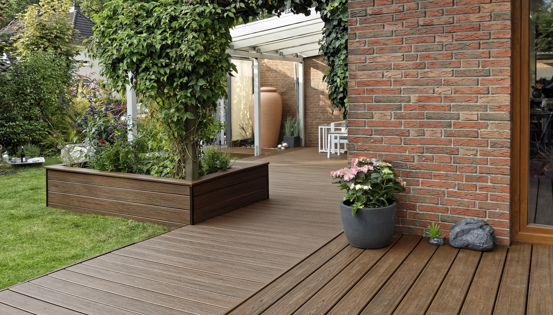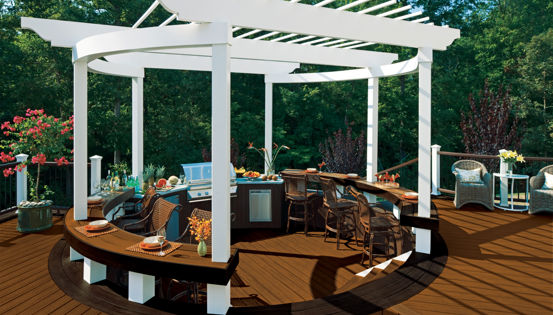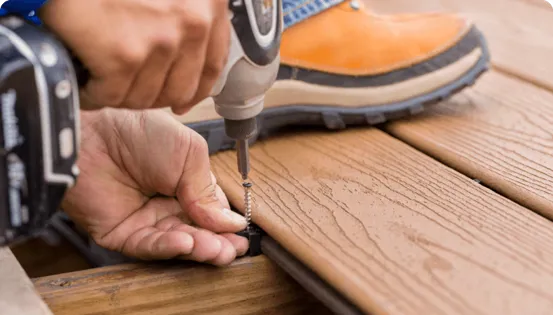If your deck has seen better days—whether your neighbors are pointing out its shabby look or it’s become so unstable that friends and family hesitate to step on it—it’s time to take action. But should you repair it or replace it entirely? This guide will walk you through the decision process.
We’ll cover how to tackle common deck problems, when it’s better to replace instead of repair, and how the costs of each option compare. You’ll also find practical tips to help you save money along the way. With this advice, you’ll feel confident about making the best choice for your deck and your home.
The cost estimates provided here are for materials only, with time and effort based on what an experienced DIYer might expect. Also, the estimates do not include time spent on planning, permits or purchasing and hauling the materials.
Cost and Time of Repairing a Deck
In most cases, repairing a deck is far less expensive than replacing it—and sometimes, that’s all a well-worn but structurally sound deck needs. Below are some common repairs that can extend the life of your deck without breaking the bank. Keep reading to learn when damage goes beyond simple fixes, and replacement becomes the better option.
It’s difficult to estimate this cost because if the deck boards are in bad enough shape to be replaced, you can bet the structure, or framing, will also need to be fixed or replaced.
Replace Loose or Damaged Boards
A loose nail can injure someone’s foot or cause a nasty fall, so they should be repaired as soon as discovered. But don’t just pound a nail back down, because it will almost assuredly pop right back up. A better plan is to pull the nail and use a screw instead. And if a screw gets loose from a wood or composite deck board, you may want to replace it with a longer one. Read this article Wood vs Deck Screws to find out which screws work best.
If you need to replace an entire wood board because it was damaged, simply pull the nails (a cats’ claw tool works great) and replace it. Try not to hit the same nail holes in the joists with the new nails, or use screws instead. Replacing one damaged composite board held down with hidden fasteners can be a bit trickier. Your best bet is to track down the exact type of fastener used and search online for repair instructions.
Cost: New Board and Fasteners = $25 to $85
Time: 1 to 2 Hours
Secure Loose Railing Components
Inspect the fasteners securing the rails to the posts and the posts to the deck framing. If you notice any loose nails or screws, consider reinforcing the structure by adding extra screws to stabilize the loose components. However, avoid simply hammering or tightening the existing fasteners, as they are likely to loosen again over time. Instead, use longer or additional deck screws for a more secure hold. To prevent the wood from splitting, ensure that new fasteners are placed at least 1 inch away from the edges or ends of the boards.
Cost: Construction Screws = $10-$15
Time: 1 Hour
Shore Up Wobbly Railing Posts
Sometimes a post can be stabilized by adding long structural screws that run through the posts into the framing. Posts held in place by through bolts, nuts and washers can be fixed up by simply tightening the nuts. If loose nuts is the problem, you can avoid having them come loose again by adding a little thread lock to the bolts before retightening the nuts. One common cause of loose railing posts is inadequate blocking. Installing blocking between the joists is essential to ensure the posts are securely supported on all four sides. Read more about fixing a wobbly railing.
Cost: Lumber for Blocking and Structural Screws = $50-$75
Time: 1 to 4 Hours
Replace Broken Baluster
Balusters attached with brackets or to the sides of the rails or skirt board are easy enough to replace. Just remove the fasteners; pull off the damaged baluster, and install a new one. If a baluster is recessed into the top and bottom rail, you will have to drill the hole deeper into the top rail, so you can push the baluster up into it far enough so that it can be slid down into the bottom rail. Add a little adhesive into the bottom rail before inserting the baluster, so that a child can’t accidentally pull it up and out.
Cost: New Baluster and Adhesive = $20-$35
Time: 1 to 2 Hours
Sturdy Bouncy Stairs
If your deck stairs have the proper number of 2x12 stringers, but are still bouncy, you can help sturdy them by attaching 2x4s or 2x6s alongside each stringer. Make sure the boards run the full length of the stringers, and push them up tight against the bottom corner of the stair treads. Exceptionally long stair runs may have to be supported with additional footings and support posts.
Cost: Four 2x6s and Fasteners = $85 to $100
Time: 2 to 3 Hours
Refresh a Weathered Wood Finish
A fresh coat of finish can go a long way to bringing a tired looking but structurally sound deck back to life. Before you start, it’s important to identify whether the existing finish is a paint, stain, or sealer, as that will determine the prep work required. For example, a solid-color stain or paint may need to be stripped or sanded off, while a transparent or semi-transparent stain might just need a good cleaning with a pressure washer. Find out more about cleaning a deck.
Weather also plays a big role in deck refinishing. The deck needs to be completely dry before applying any new finish, which may mean waiting a few days after rain or a thorough cleaning. Aim for a window of dry, mild weather—ideally between 50°F and 80°F—for best results. And don’t forget to choose the right finish for your deck’s material and exposure. High-traffic or full-sun decks may benefit from more durable, pigmented stains, while shaded areas often get by with a lighter, penetrating oil finish. Proper prep and timing are key to a long-lasting, professional-looking result. Learn more about restoring deck boards.
Cost: Two Gallons of Premium Deck Finish and Finishing Supplies = $100 to $300
Time: 8 to 12 hours (sometimes yearly)
When Should You Replace Your Deck?
Even the best-built deck won’t last forever. While regular maintenance and occasional repairs will extend the life of your deck, there comes a point when those efforts might no longer be enough to keep it safe and functional. Also, if your deck simply no longer compliments your home’s aesthetics, replacement might be the more practical choice. Here’s how to tell if your deck is past its prime.
Wood Rot and Infestation
If water from the roof has been dripping on one section of the handrail and caused it to rot, you could probably repair just that section. However, if you find rot or an insect infestation in several areas of your deck, there’s a good chance the problem is more widespread than you think. One simple way to check for rot and insect infestation is to probe suspect areas with a screwdriver—if the wood feels soft, crumbles easily, or you can sink the tool in more than 1/8 in with little resistance, it’s likely time to consider a full replacement.
Structural Defects
If you're considering buying a home with an existing deck, it's important to ensure it meets current structural standards. During the home inspection process, ask the inspector to pay close attention to the deck's condition. Alternatively, you can contact your local building department to verify whether a permit was issued and if the deck was inspected at the time of construction. Below are some common areas of potential failure to check, along with helpful articles and videos to guide you in assessing the safety of a deck:
- Ledger Connection
- Post and Beam Construction
- Joist Size and Spacing
- Joist Hangers
- Stair Construction
- Footing Size and Locations
- Railing Code Requirements
- Handrail 101
Your Deck is Old
A well-maintained, properly constructed deck can last well over 50 years if built in a shady area in an arid climate that receives very little rain. However, that same deck might only last half as long if it’s attached to a house located in a region that experiences a lot of rain and harsh winters. No matter the location or level of upkeep, every deck will eventually require replacement. Sometimes, it’s not a single component that's significantly damaged but rather the overall wear and tear across all parts that makes replacement necessary.
It’s Just Plain Ugly
Over time, sun, rain, snow, and foot traffic can break down the surface fibers of deck boards, leaving them gray, splintered, and porous. In this degraded state, the wood may no longer properly absorb or hold a new coat of stain or sealer. Instead of penetrating and protecting the wood, the finish may simply sit on the surface and quickly peel or flake away.
If cleaning and sanding no longer restore the wood’s ability to take a finish, it’s often a sign that the boards have reached the end of their useful life and should be replaced. In some cases, even if the deck is structurally sound, outdated materials or mismatched design—especially after a home remodel—can make the exterior feel disjointed and diminish your home’s overall visual appeal and value.
Average Cost and Time to Rebuild a 300 sq ft Deck with Railing
Thinking about the cost of rebuilding your deck? Here are some general guidelines for constructing a 15 ft. x 20 ft. deck with 50 linear ft. of railing (without stairs). In some cases, you might only need to replace the decking or railing, rather than the entire structure, which can save time and money. While most minor repairs typically don’t require a building permit, building a new deck almost always does. Be sure to check with your local building department before you start planning your project to ensure everything is up to code.
Disclosure:
The prices listed above are based on national averages and are intended to serve as general guidelines only. Actual costs can vary significantly depending on your location, material availability, labor rates, and the specific details of your project. For the most accurate pricing, we recommend getting multiple quotes from licensed contractors in your area and checking with local suppliers for current material costs. Decks.com is not responsible for changes in pricing or project outcomes based on these estimates.
Demolition and Disposal of Existing Deck
- Landfill Fees (if you haul it) $80 to $180
- Dumpster Rental $300 to $500
- Total: $80 to $500
- Time to Complete: 2 Days
H3 Cost of permit fees
- Rural $50 to $200
- Urban $100 to $700
- Total: $50 to $700
- Time to Complete: 1 to 3 Weeks
New Footings
- Post Hole Digger Rental $75 to $100
- Concrete Form Tubes $75 to $100
- Bagged Concrete $100 to $250
- Total: $250 to $450
- Time to Complete: 1 to 2 Days
Framing Lumber and Structural Hardware
- Framing Lumber $800 to $1200
- Structural Hardware $250 to $400
- Fasteners $80 to $200
- Total: $1130 to $1800
- Time to Complete: 2 to 4 Days
New Decking
- Pressure Treated Wood: $3 to $6 per sq. ft. = $900-$1800
- Cedar Decking $4 to $8 per sq. ft. = $1200 to $2400
- Composite Decking $5 to $13 per sq. ft. = $1500 to $3900
- Total: $900 to $3900
- Time to Complete: 2 to 3 Days
New Railing (50 linear ft)
- Wood Railing: $15 to $30 per linear ft. = $750 to $1,500
- Composite Railing: $40 to $80 per linear ft. = $2,000 to $4,000
- Metal Railing: $50 to $100 per linear ft. = $2,500 to $5,000
- Specialty Railing like Cable or Glass: $80 to $150+ per linear ft. = $4,000 to $7,500+
- Total: $750 to $7500+
- Time to Complete: 2 to 4 Days
Total Costs for Removing and Rebuilding a 15 ft. x 20 ft. Deck with Railing
- Cost for building a 300 sq. ft. deck with 50 linear ft. of railing can run anywhere from $3160 to $14,850+
- Time to Complete: 8 to 15 Days
Already have a good idea of the type of materials you want to use? You might be able to fine tune these numbers with this deck cost calculator.
Factors that Increase the Cost of Replacement
In addition to the materials you choose, several design and construction factors can significantly impact the overall cost of your deck project. While some upgrades may be well worth the investment for aesthetics or functionality, others can push your project way over budget.
- Multi-Level or Second-Story Design: Elevated or multi-level decks require additional structural engineering, footings, and support posts. If your deck is attached to a second story or includes multiple platforms, it will also need stairs and railings—both of which add labor and material costs. Working at height also increases complexity and time, especially for contractors.
- Custom Designs: Picture framing a deck, laying decking boards diagonally or incorporating curves looks great, but usually requires more lumber, creates more waste and adds more time.
- Add-Ons and Built-Ins: Features like built-in benches, planter boxes, privacy screens, lighting, pergolas, or a roof structure can greatly enhance your outdoor space, but each one adds materials, labor, and sometimes permitting requirements and fees.
- Contractor Fees: Labor rates vary by region and contractor experience. Do to higher operating costs, contractors in urban areas often charge more than those in rural areas.
How to Save Money on Your New Deck
Understanding what makes a deck cost more is only half of the equation. Here are some great tips to help you cut costs on your upcoming deck project.
- Check Your Insurance Policy: If your deck has been severely damaged by a storm, your homeowners’ insurance might cover the repairs or replacement costs. Review your policy to see if you're eligible for assistance—it could save you significant money.
- City Disposal Services: Some municipalities provide disposal services for their residents. So, before you call for that dumpster delivery, check with your local city or county and ask if they will take your deck demo debris.
- Plan Thoughtfully: Design your deck to accommodate available deck boards and common railing lengths. You can also save money down the line by building your new deck frame, so it can handle future expansions like hot tubs and pergolas.
- Use Available Products: Choosing materials and colors that are stocked by local lumberyards and home centers will cost less than products that can only be purchased through special orders. Find out more about where to buy your decking here.
- Choose Long-Lasting Materials: Pressure-treated wood decking and railings will cost less initially, but they often require more time and money over the years for maintenance and repairs. They also don’t last as long as low-maintenance options like composite decking and aluminum railing, which might be a better value in the long run.
- Do It Yourself: If you're a confident DIYer, building your own deck can be a major cost-saver. Even if you're new to DIY, tasks like demolishing the old deck, installing footings, or laying decking are great beginner projects to get started. For more advanced tasks, such as framing stairs or attaching a ledger board, consider your skill level before diving in. Regardless what your skill level is, you will find some helpful tips and resources for DIY deck projects here.
- H3 Hire the Right Contractor: An experienced contractor may charge more upfront, but can also help you avoid costly mistakes and ensure your deck is built to code and will stand the test of time. On the flip side, hiring the lowest bidder could mean cutting corners—it’s important to weigh value over just cost. The best contractor to hire is the one that has experience, a solid reputation and is knowledgeable about the products they are working with. Find out more about hiring a contractor.
By following these tips, you can manage costs effectively and ensure your deck project is built to last—without breaking the bank.
